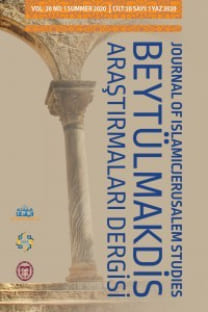KUDÜS’E GELEN RUS HACILARIN MÜRÛR TEZKİRESİ MESELESİ
Kudüs, Rus hacılar, Osmanlı-Rus ilişkileri, Hristiyan, hacılar, Rus hacılar, mürûr tezkiresi, Osmanlı-Rus ilişkileri
The Issue of Mürûr Tezkiresi (trip permit) for Russian Pilgrims coming to Jerusalem
Jerusalem, Russian pilgrims, Christian, pilgrims, Russian pilgrims, travel permits,
___
- Başbakanlık Osmanlı Arşivi (BOA)- A.}DVN.NMH, 33.15.1.1, 29 Z 1313/ 30 Mayıs 1312 (11 Haziran 1896).
- - BEO, 2562.192111.7.1, 14 Mart 1321 (27 Mart 1905)
- - BEO, 2562.192111.5.1, 28 Muharrem 1323/ 22 Mart 1321 (4 Nisan 1905)
- - BEO, 2551.191279.1, 6 Safer 1323/ 29 Mart 1321 (11 Nisan 1905)
- - BEO, 2562.192111.2.1, 15 Safer 1323/ 7 Nisan 1321 (20 Nisan 1905)
- - BEO, 2562.192111.4.1, 17 Safer 1323/ 9 Nisan 1321 (22 Nisan 1905).
- - BEO, 2562.192111.1, 21 Safer 1323/ 13 Nisan 1321 (26 Nisan 1905).
- - BEO, 2770.207709.3.1, Muharrem 1324/ Şubat 1321 (Şubat 1906).
- - BEO, 2759.206902.1, 18 Zilhicce 1323/ 29 Kanun-ı sâni 1321 (12 Şubat 1906).
- - DH.MKT, 2339.96.1, 2 Muharrem 1318/ 18 Nisan 1316 (1 Mayıs 1900).
- - DH.MKT, 2403.9, 20 Cemaziye’l-evvel 1318/ 2 Eylül 1316 (15 Eylül 1900).
- - DH.MKT, 997.13.5.1, 4 Zilhicce 1323/ 16 Kanûn-ı sânî 1321 (29 Ocak 1906)
- - DH.MKT, 997.13.6.2, 18 Kanun-ı sâni 1321/ 6 Zilhicce 1323 (31 Ocak 1906).
- - DH.MKT, 997/13/8/2, 19 Muharrem 1324/ 2 Mart 1322 (15 Mart 1906)
- - DH.MKT, 1193/9/2/1, 15 Receb 1325/ 11 Ağustos 1323 (24 Ağustos 1907)
- - DH.MKT, 1259/33/3/1, 4 Receb 1326/ 19 Temmuz 1324 /1 Ağustos 1908)
- Avcı, Y. (2004). Değişim Sürecinde Bir Osmanlı Kenti: Kudüs (1890-1914), Ankara: Phoenix Yay.
- Aybay, R. (1985, Ocak). “Son Dönem Osmanlı, TBMM Hükumeti ve Erken Cumhuriyet Dönemlerinde Pasaportlar”, Tarih ve Toplum, c. 3/13, (ss. 46-53).
- Çadırcı, M. (1993). “Tanzimat Döneminde Çıkarılan Men‘-i Mürûr ve Pasaport Nizâmnâmeleri”, Belgeler, cilt 15, no. 19, (ss. 169-182).
- Georgevich, T. S. (1918, Ocak). “Serbia and the Holy Land”, Journal of Theological Studies, no. 74-75, (ss. 97-114)
- Gerber, H. (1985). Ottoman Rule in Jerusalem 1840-1914, Berlin: Klaus Schwarz Verlag.
- Graham, S. (1913). With the Russian Pilgrims to Jerusalem, Londra: Macmillian and Co.
- Hummel, T. (2010) “Russian Pilgrims: A Peasant Army Invades Jerusalem”, Jerusalem Quarterly, v. 44, s. 40, (ss. 39-44). Bancroft, J. M. (1890). Deaconesses in Europe and Their Lessons for Amerika, New York: Hunt & Eaton.
- Kane, E. M. (2005). “Holy Places and the Multi-Confessional Empire, Russian Policy Toward the Ottoman Empire under Tsar Nichola 1825-1855”, Yayınlanmamış Doktora Tezi, Princeton Üniversitesi.
- Kapitülasyonlar: Tarihi, Menşei, Asılları, Macar İskender ve Ali Reşad (çev.), İstanbul: Dersaadet Kanaat Matbaası, 1330.
- Kushner, D. (1999). “From Eyalet to Sancak: The District of Acre in Transition, 1840-1918”, XIII. Türk Tarih Kongresi, 04-08 Ekim 1999, Ankara, Erişim adresi: http://www.ttk.gov.tr/yayinlarimiz/xiii-turk-tarih-kongresi-04-08-ekim-1999-ankara-iii-cilt-iii-kisim/ s. 2024 .
- Kütükoğlu, M. (2006). “Mürûr Tezkiresi”, TDV İslâm Ansiklopedisi, cilt: 32, TDV İslâm Araştırmaları Merkezi, Erişim adresi: https://islamansiklopedisi.org.tr/murur-tezkiresi .
- Mazza, R. (2009). Jerusalem From the Ottomans to the British Rule, Londra, New York: Tauris Pub.
- Muâhedât Mecmûası, Ankara: TTK, 2008, cilt 1, cilt 2, cilt 3.
- Sâlname-i Vilâyet-i Beyrut, 1310 sene-i maliye, Beyrut, 1310.
- Sezer, H. (2003). “Osmanlı İmparatorluğu’nda Seyahat İzinleri”, A.Ü. Dil ve Tarih-Coğrafya Fak. Tarih Araştırmaları Dergisi, cilt XXI, sayı 33, (ss. 105-124).
- Turna, N. (2013). 19. Yy’den 20. Yy’ye Osmanlı Topraklarında Seyahat, Göç ve Asayiş Belgeleri Mürûr Tezkireleri, İstanbul: Kaknüs Yayınları.
- ISSN: 1367-1936
- Yayın Aralığı: Yılda 2 Sayı
- Başlangıç: 1997
- Yayıncı: Beytülmakdis Çalışmaları Vakfı
OSMANLI KUDÜS’ÜNDE KAÇAKÇILIK FAALİYETLERİNE GENEL BİR BAKIŞ (1886-1914)
XIX. YÜZYILIN İKİNCİ YARISINDA SİYONİSTLERİN FİLİSTİN’E YERLEŞMELERİNİN ENGELLENMESİ
Beytülmakdis'in Osmanlı Anıtları: Creswell'in 1919-1920 Arşiv Fotoğraf Koleksiyonunun İncelenmesi
KUDÜS’E GELEN RUS HACILARIN MÜRÛR TEZKİRESİ MESELESİ
KAISERSWERTHER DİYAKONEZLERİ'NİN KUDÜS'TEKİ FAALİYETLERİ VE TALİTHA KUMİ OKULU
Osmanlı Döneminde Kudüs'te Zaviyelerin Yayılması ve Gelişmesinde Vakıfların Rolü
